How grapes should be planted in autumn
Farmers differ on whether to plant grape bushes in fall or spring. Spring planting eliminates the risk of freezing of young shoots. However, winter plants have more stable immunity and quickly enter the vegetation stage.
The article discusses the features of the autumn method of growing grapes.
The content of the article
The best grape varieties to plant in the fall
For growing before winter choose varieties that are most resistant to low temperatures and intended for cultivation in a particular region. For the southern and middle lane, frost-resistant varieties with an early ripening period are suitable. Late maturing plants are best left for planting in spring.
They take into account the ripening period of the bunches, the culture's immunity to disease, drought, frost resistance, productivity and ease of care. Planting material is recommended to be purchased in special stores and nurseries.
Experienced growers recommend the following varieties:
- Isabel;
- Cardinal;
- Transformation;
- Lady fingers;
- Delight;
- Julia;
- Fantasy;
- Muscat Azos.
Selection and preparation of planting material
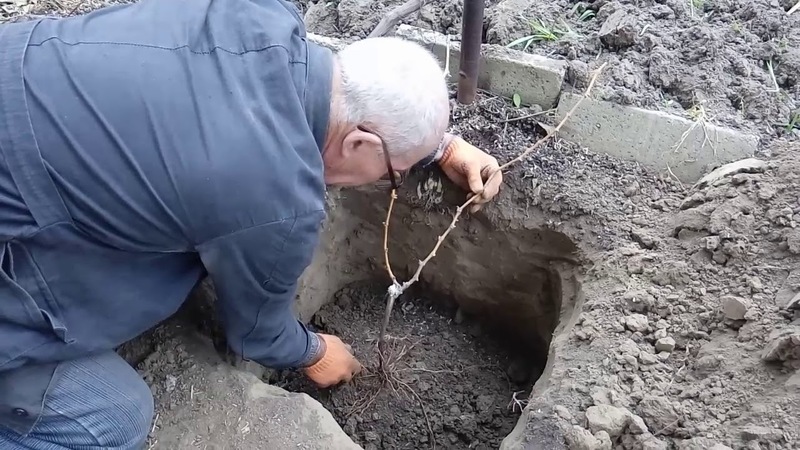
The successful cultivation of vines begins with the selection of quality planting material. There are several ways to propagate a culture: seedlings, seeds, shanks.
Important! In order for the bushes to better adapt to climatic conditions, local grapes are chosen.
Regardless of the growing method, the general rules for choosing plants are observed:
- the root system of the seedling contains 3–6 young shoots with heel roots up to 15 cm long;
- the trunk reaches 40–55 cm in height with a stem thickness of 8 mm;
- on the trunk there are green shoots up to 20 cm long and up to 4 buds;
- the color of the shoots is bright green, the color of the trunk is deep brown: this indicates the strength of the plant, its resistance to damage;
- buds, roots and stem without damage, white root cut;
- the age of the seedling is up to 2 years, since the old bushes do not take root well or do not bring the desired harvest;
- bushes with a closed root system (an open one must have an earthen coma on the roots);
- the trunk and leaves are not damaged, there are no traces of fungus and other diseases;
- planting seeds are hard to the touch, beige-brown in color with a white liquid under the shell.
Planting material is prepared in different ways:
- Seedling roots 2 days before planting, soak for 12-24 hours in boiled water at room temperature with a growth stimulant diluted in it. Immediately before planting, the upper roots are removed, the lower ones are shortened by 1-2 cm. The shoots are cut, leaving 3-4 buds, and the roots are dipped into a solution of clay with humus. The bushes are treated with any fungicide.
- To check seeds they are lowered into the water for viability: those that have emerged are unsuitable for sowing, those that have sunk to the bottom are healthy. The selected specimens are subjected to stratification: they are placed in water for a day so that they stratify, or they are laid out in wet nylon bags, wrapped in polyethylene and sent to the refrigerator, to the vegetable compartment. The material is periodically inspected and washed to avoid decay. After 50-60 days, when cracks appear on the seeds, they are ready for planting in the ground.
- Chubuki taken during grape pruning.Choose branches 30–40 cm long with well-developed buds, soak in a solution of potassium permanganate for several hours, then rinse with clean water and dry. Then cut 1-2 cm on both sides, placed in a solution with a growth stimulator for 2-3 days and continue to germinate in clean water at a temperature of + 24 ... + 26 ° C until roots 7-8 cm long appear.
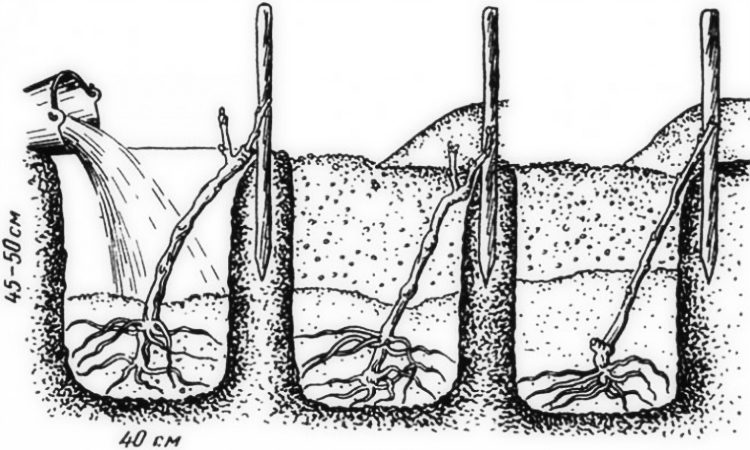
Landing dates
The main condition for the correct formation of grape bushes is adherence to planting dates. In this case, the climatic conditions in the region must be taken into account.
Late cultivated bushes do not take root well and may not survive the winter without having time to adapt to weather conditions. The land gives off the heat accumulated over the summer to the bushes planted in time, so the seedlings will get stronger over the winter and will quickly enter the growing season in the spring.
The time of disembarkation is chosen so that before the arrival of the first frost there are 30–45 days, the daytime air temperature was + 15 ... + 16 ° C, the night temperature did not fall below + 5 ... + 6 ° C
For central Russia and the Moscow region, this is the period from the beginning to the end of October, for the southern regions - mid-October - early November. In the Leningrad Region, seedlings are planted from late August to early September; in Siberia and the Urals, the first half of September is suitable for this.
The period is designed for planting young bushes, for divided plants and layering, the period is postponed 2 weeks later.
How to properly plant grapes in autumn
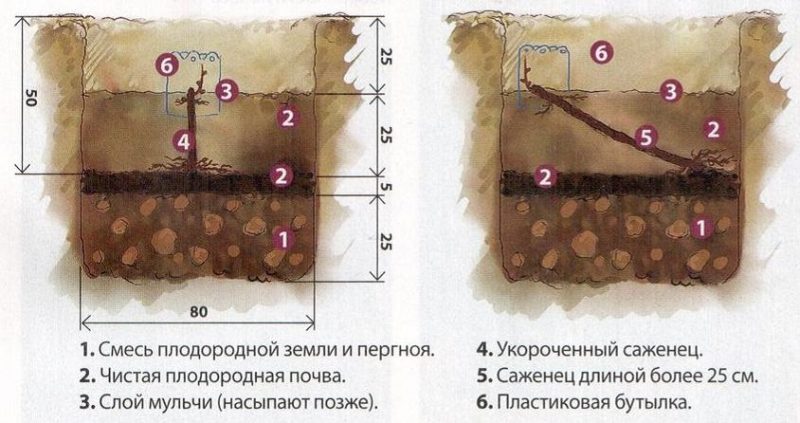
Planting a crop before winter requires compliance with a number of important conditions. At first glance, cultivation seems unnecessarily time-consuming, but in fact it is quite affordable even for beginners.
Seat selection
The choice of the site is approached responsibly, since it depends on whether the plants survive the winter and how soon they will please the owner with sweet berries.
When choosing a place, take into account the following points:
- The vineyard is not placed in the northern areas - it is better to choose a sufficiently lit place on the south side, not far from the wall of the house or fence. The wall heated during the day will share the heat with the bushes, and the cold northern winds will not damage the seedlings.
- Tall trees, spreading shrubs and fruit crops are not grown nearby. The optimal distance between them is at least 4 m.
- A ravine or lowland is not suitable, where the air temperature is always lower than on a hill. Do not plant grapes on swampy lands, areas with dense clay soil.
- Planted on well-loosened, organic-rich soil containing phosphorus and potassium compounds. Avoid areas with groundwater at a distance of 1.5 m from the roots.
Required materials and tools
Before landing, a shovel, a bucket for irrigation, drainage material (crushed stone, broken brick, expanded clay or gravel) are prepared in advance. You will need humus and fertilizers, wood ash.
Step-by-step instruction
The cultivation of grapes with seedlings begins with the preparation of indentations (depth and diameter - 80 cm). They are dug up 3 weeks before planting to allow the soil to settle and ensure the optimal position of the bushes relative to ground level. The top layer of fertile soil 30–40 cm thick is laid separately from the rest.
Drainage is placed on the bottom of the pits, 1/3 of the upper soil layer mixed with 15 kg of humus, 0.5 kg of superphosphate and 1 kg of wood ash is poured on top. The soil is covered with a layer of plain earth to avoid root burns, pour 2-3 buckets of water.
After 3 weeks, when the soil has settled, pegs are placed in the center of the recesses, to which the bushes will subsequently be tied. A part of the nutrient soil is poured nearby, on which the seedlings are placed, placing the roots at an angle of 45 ° so that they do not break.
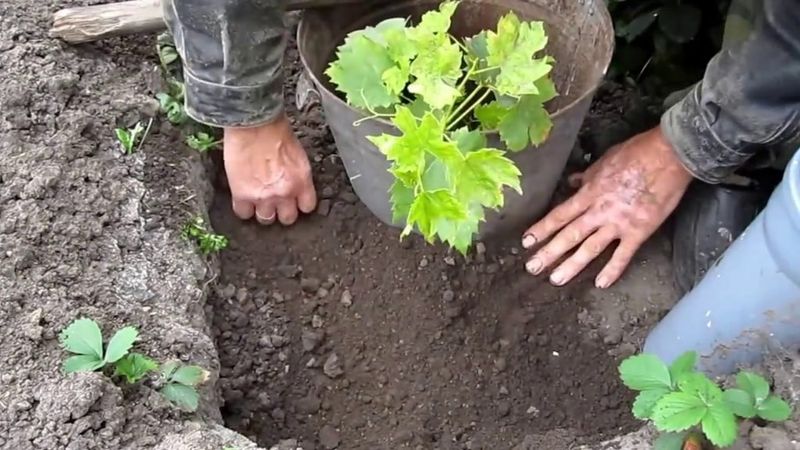
Gradually filling the hole with soil, tamp each layer until the surface of the earth reaches the root collar.
Important! The bushes are watered abundantly with water, the soil is sprinkled with dry peat, sawdust or dry soil.
To plant cuttings and shanks, a trench is dug 25–35 cm deep and 1 m wide.The bottom is covered with humus, if necessary, a drainage layer is created, and an interlayer of nutrient soil is made on top. The cuttings are buried by 2 buds into the ground, tilting to the south, covered with plastic bottles or film stretched over arcs. The trench is filled with warm water.
What mistakes to avoid
Inexperienced farmers make a number of mistakes that negatively affect the survival rate, growth and quality of berries.
Major misses:
- use seedlings of an unknown variety that do not correspond to the climatic zone, with a weak root system;
- form an unnecessarily or insufficiently deep hole or trench for planting: the first will slow down the growth of bushes due to low soil temperatures, and the second will limit the supply of nutrients and moisture to the seedlings;
- place bushes close to each other, otherwise the plants will fight for moisture and lighting, fungus will appear;
- plant only varieties with a female type of flowering, which leads to the grinding of bunches;
- abandon watering immediately after planting in soil moist from rain: even if it rained, watering is mandatory so that air tunnels do not form in the soil layer.
Planting methods
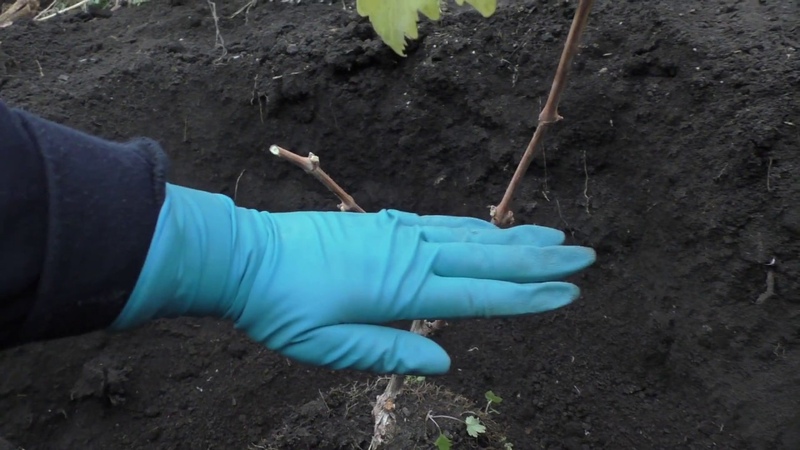
Depending on the type of planting material chosen, the methods of its cultivation also differ:
- Saplings buried in the soil to the depth of the fourth bud, at a distance of 1–1.5 m from each other. Small mounds are created around the trunks.
- Cuttings placed in a trench filled with 2-3 buckets of warm water, at a distance of 15-25 cm from each other with a slope to the south, leaving 2 buds on the surface. For fast rooting, cover with foil for the first time.
- Chubuki, sprouted and planted in a similar way to cuttings, cover with foil or plastic bottles, which have the bottom cut off. This will speed up rooting and protect young plants from cold and damage.
- Seeds pre-germinate in a small container with humus and sand (1: 1), periodically watered and fertilized. In May, the sprouts dive into a larger container, kept on the loggia. Closer to autumn, plants are hardened in order to transfer them to open ground without loss. They are planted at a distance of 2–2.5 m in compliance with the basic rules.
Further care
After planting, the bushes are watered, no additional fertilizers are applied. Between wetting, the soil is gently loosened so as not to damage the roots.
When frosts come, the shoots are covered. For the southern regions, an earthen hill 0.5 m high or straw, spruce branches, leaves, plastic bottles without a bottom are enough. In more severe winter conditions, the stems are wrapped in polyethylene, roofing felt or tarpaulin. If this is not enough, the bundle is placed in an earthen tunnel and covered with leaves, sawdust, spruce branches.
In the spring, before the appearance of young shoots and leaves, a trellis is installed for garter plants. This procedure increases yields and reduces the risk of developing diseases.
Read also:
The best ways to freeze raspberries for the winter correctly.
When and how to properly prune raspberries in the fall.
How to properly prepare raspberry leaves for the winter for tea at home.
Landing features depending on the region
To successfully grow grapes in any area, choose suitable crop varieties, taking into account the climatic characteristics of the region:
- in Siberia, in the Urals, in the Leningrad region, where there are severe frosts, cold-resistant early maturing varieties are planted: Thumbelina, Buratino, Siberian Cheryomushka;
- frost-resistant early crops, unpretentious in care, resistant to fungal diseases, are suitable for the Central strip and the Moscow region: Venus, Tenderness, Lunny.
Conclusion
Cultivation of young grapes is a laborious process, but quite feasible. Observing the rules of planting and care, taking into account the peculiarities of the climate in the region, every farmer will be able to grow healthy bushes and get a rich harvest of sweet berries.